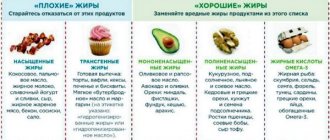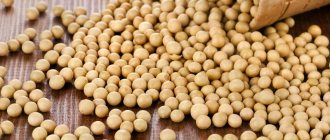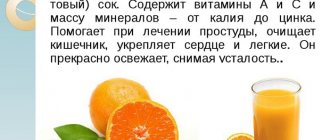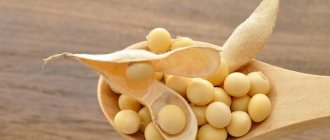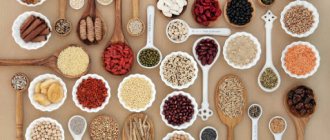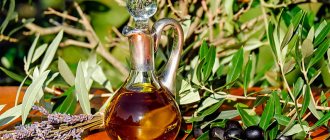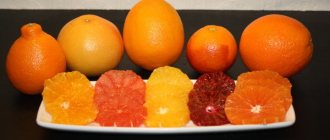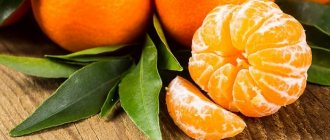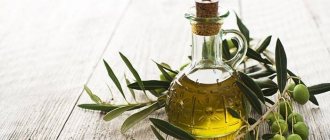In this article we will tell you:
- Types of fats
- Animal and vegetable fats
- Healthy and unhealthy fats
- The body's need for fats
- Basic rules for eating fats
- Recommendations for creating a complete diet
- Balance between Omega-3 and Omega-6 PUFAs
- Sources of Polyunsaturated Omega-3 Fatty Acids
- Benefits of fish oil
- Is cholesterol really that bad?
- Top 10 Foods Rich in Healthy Fats
Fats
- organic compounds containing trihydric alcohol glycerol and free fatty acids. They are one of the main, vital classes of nutrients and perform a number of multidirectional beneficial effects in the body. They are part of cells and tissues, largely giving the latter their specific functions. For example, the myelin sheath of nerves, the main components of which are phospholipids, cholesterol and cerebrosides, ensures isolated conduction of impulses. Fats also form a kind of internal lining of the alveoli - a surfactant, preventing them from collapsing during certain phases of the respiratory cycle.
The energy value of these compounds is more than 2 times higher than that of proteins and carbohydrates: for example, when 1 gram of fat is burned inside the furnaces of our cells, 9.3 kilocalories are released.
Other, no less significant functions are:
- Thermal insulation
— it is this that determines the importance and nature of the deposition of subcutaneous fat.
- Structural
- from biology lessons, many remember the so-called bilipid layer of the membrane - that barrier, the selectively permeable boundary between the internal environment of the cell and the extracellular substance, which, like at the airport at passport control, decides what substances can get in or, on the contrary, get out, and which way - entry is strictly prohibited.
- Regulatory
- the chemical nature of some vitamins (A, D, E, K), as well as hormones (in particular, sex hormones), signaling molecules (both pro-inflammatory and anti-inflammatory) are based on fats - and this significantly expands the entire arsenal of performed functions. For example, prostaglandins, derivatives of arachidonic acid, are important building blocks in the tirelessly building wall of inflammation and are involved in increasing the permeability of vascular walls, their dilation, and the development of edema.
- Shock absorbing
function - they protect internal organs from various types of damage.
Types of fats
Depending on the chemical structure (that is, on the molecules that make up them), all fats can be divided into simple and complex, and within each of these categories, in turn, quite long lists can be compiled with all subspecies and their derivatives.
Nowadays, the division into saturated and unsaturated is very common, depending on the nature of the bond between the hydrocarbon atoms. However, this does not apply to fats, but to fatty acids - one of the two essential components from which lipids are formed.
To saturated fatty acids
(that is, having purely single bonds)
include the following:
propionic, palmitic, stearic. They are rich in animal fats, cocoa butter, butter, palm, coconut and ghee oils.
Unsaturated fatty acids
(in the carbon chains of which double or triple bonds are found)
can be divided into two large groups:
- Monounsaturated fatty acids
(MUFA) contain one double bond.
- Polyunsaturated
(PUFA) – two or more. Perhaps their most striking representatives, and now especially popular among the general population, are Omega-3 and Omega-6.
Omega-3 PUFAs include eicosapentaenoic acid (EPA) and docosahexaenoic acid (DHA), which come directly into the body or are formed from essential (that is, not able to be synthesized within our body) alpha-linolenic acid. They are involved in various processes in our body - their function is not limited to just an anti-inflammatory role.
DHA greatly influences both the development of the nervous system, its differentiation at an early age, and cognitive abilities in adults. Numerous studies show that its lack in the diet leads to impaired memorization and, as a result, learning, deterioration of concentration and attention. So, this organic compound is responsible for the growth of neurons.
In addition, it is very effectively used in the treatment of depression, especially postpartum. It also inhibits the production of pro-inflammatory signaling molecules (such as, say, tumor necrosis factor and interleukin-6). Docosahexaenoic acid is also involved in visual function - its concentration in the photoreceptors of the retina is very impressive.
Study
: Long-chain polyunsaturated fatty acids and their role in baby nutrition
Eicosapentaenoic acid is actively used in the treatment of type 2 diabetes mellitus: it increases the sensitivity of receptors to the protein hormone insulin, thereby helping glucose get from the bloodstream into the cell. It promotes the production of adiponectin by adipose tissue, a hormone that regulates energy metabolism and also has a pronounced pro-inflammatory effect. EPA, as new studies have shown, prevents the development of coronary heart disease in patients with elevated plasma cholesterol levels and, having a nephroprotective effect, reduces the risk of Alzheimer's disease.
Study
: Eicosapentaenoic Acid (EPA) Modulates Glucose Metabolism by Targeting AMP-Activated Protein Kinase (AMPK) Pathway
Harmful properties
Vegetable fats, a list of products containing which is needed to create a daily menu, may include unsaturated and saturated fatty acids. Their regular excessive consumption along with trans fats negatively affects overall health and leads to exacerbation of various chronic diseases.
The content of animal fats in the diet should not exceed the norm in case of increased fragility of the vessels of the circulatory system. A danger to the human body are trans fats obtained during the process of hydrogenation based on the heat treatment of vegetable fats, the composition of which changes.
The concentration of trans fats in processed foods increases to 50%. The structure of these dangerous fats consists of modified molecules formed in unsaturated oils.
Baked goods and fast food are saturated with trans fats, which do not benefit human health, but worsen it. Ingestion of trans fats in excess amounts leads to increased cholesterol in the blood and its deposition on the walls of blood vessels, the development of tumors, degenerative processes in the kidneys and liver, and the formation of stones in them.
This process is accompanied by a weakening of the immune system and a deterioration in the absorption of polyunsaturated fatty acids (Omega-3, Omega-6 and Omega-9) in the body, which is important for normal human life.
The principle of dividing fats into saturated and unsaturated depends on the content of fatty acids and glycerol in their composition. Knowing their percentage, you can determine the daily intake of saturated fats, which will not cause harm to the body as a result of their regular consumption.
Exceeding this norm leads to the negative effect of saturated fats, which is associated with excessive stress on the heart muscle, with a general deterioration in health and the development of the following types of pathologies:
- of cardio-vascular system;
- diabetes mellitus;
- atherosclerosis;
- obesity;
- increased blood clotting;
- increased blood pressure;
- disruption of metabolic processes in the body.
Excess fat consumed along with food is harmful to the body. It is important to avoid artificial fats or trans fats.
Animal and vegetable fats
In many ways, the chemical structure of fats depends on their origin: plant or animal. This determines, as a rule, their consistency and the nature of the bonds (saturated or unsaturated) in the carbon chain. In general, a rational, healthy diet, according to experts, includes both sources.
The variety of vegetable fats is truly impressive: many cereals, nuts, seeds and even vegetables contain them. Oils are produced from seeds, fruits and seeds: sunflower, olive, rapeseed, flaxseed, hemp, grape, cedar and many others. There are several ways to obtain them:
- Pressing
- this technology is more gentle, but is considered less effective: the cake remaining after squeezing contains a large percentage of fat.
- Extraction method
. At the same time, the organic solvents used in the process help to isolate almost all healthy fats from the raw materials.
The food and processing industries use raw materials of various origins (mainly bones and adipose tissue) to produce animal fats, containing large quantities of saturated fatty acids: stearic and palmitic.
This type of organic compound usually enters the human body in the following products:
- Meat and offal
.
- Fatty fish
- An excellent source of omega-3 and fat-soluble vitamins. However, it is worth considering that the absorption of the latter is possible only if there is an adequate outflow of bile, which acts not only as an emulsifier, but also activates pancreatic enzymes.
- Chicken eggs
- an excellent source of fats and protein, as well as choline (in the body it is included in the synthesis of one of the main neurotransmitters - acetylcholine), vitamin E and biotin.
- Milk, cottage cheese, cheese, sour cream, cream
(fat content up to 30%)
, butter and ghee GHI
.
Despite the wide range of beneficial effects that fats have, one should not forget about their fairly high calorie content. Thus, weight loss may be at significant risk if, say, you pour olive oil on your salad to your heart's content. Healthy? Undoubtedly! But only under the condition of sufficient physical activity and within the required caloric intake that satisfies the needs of your body.
Harm and benefit
In a simplified sense, fat is the main source of energy for the body (80% of human energy reserves). Vegetable oil contains various acids, phytosterols, and phospholipids, which are absolutely important for normal metabolism. Nutritionists strongly recommend completely abandoning solid and animal fats, because vegetable oil has more beneficial properties:
- polyunsaturated acids omega-6 and omega-3 are not produced by the human body, but are vital for health (prevent blood clots and increased blood pressure);
- vegetable oil stimulates tissue regeneration;
- natural first cold-pressed oils - suppliers of large amounts of vitamin E, which has a positive effect on the condition of the skin;
- vegetable fats are minimally involved in the formation of bad cholesterol, which provokes atherosclerosis;
- metabolic processes are accelerated;
- blood composition normalizes;
- proper nutrition, balancing the vegetable and meat components in the diet, promotes weight loss;
- the immune system is strengthened;
- a strong cell membrane is formed;
- heart function is normalized;
- the strength and elasticity of blood vessels increases;
- retinol and similar substances protect the body from radiation exposure, reduce the risk of cancer, diabetes, and activate protein synthesis.
It is impossible to unambiguously determine the harmfulness of fats, since the negative effect directly depends on the amount consumed and the method of processing the oil. Such a product can also be harmful if you use it exclusively, completely abandoning animal lard. A cheap product of plant origin, with fanatical adherence to diets, provokes serious consequences:
- an excess of vegetable fats without a balance with animals can cause infertility in women;
- after severe heat treatment, oxidized polyunsaturated fats provoke thinning of the artery walls;
- oxidized fats are not absorbed by the body, but settle on the walls of blood vessels, which in the future provokes heart pathologies, cancer, obesity, and diseases of the gastrointestinal tract.
- Eyebrow shadows - how to use, how to apply correctly
- Thermometer for gas and electric oven. How to choose a mechanical or digital remote thermometer
- How to pump up your biceps at home
Healthy and unhealthy fats
Just a few decades ago, low-fat diets were at the peak of popularity: they were promoted as perhaps the only and most reliable way to prevent coronary heart disease, heart attack and stroke.
However, a sharp decrease in the content of fats, which act as the most saturated foods (as many as 9 kilocalories compared to 4, which gives, for example, 1 gram of protein), led to a rapid increase in the amount of carbohydrates in the composition of manufactured products - the era of diabetes and obesity has arrived.
So, given the undeniable importance of this class of compounds, completely eliminating or reducing its portion allocated on the plate is not the most rational idea, which, at a minimum, will lead to disruptions of the menstrual cycle and the functioning of the endocrine system as a whole.
Conventionally, all fats can be divided into “healthy” and “not so healthy” - although the classification, we repeat, is very subjective.
The first group includes sources of omega-3 polyunsaturated fatty acids
- their anti-inflammatory effect and modulating effects on the cardiovascular system have been proven in dozens, if not hundreds, of studies.
As was previously said, in the realities of the modern world with its very diverse, but very often far from being as correct as we would like, diet, it is necessary to monitor the optimal ratio between omega-3 and omega-6 fatty acids: the latter act as complete antagonists , involved in many pathological processes of various localizations (it is difficult to name a mechanism in which eicosanoids - derivatives of arachidonic acid) would not be involved. In particular, the same prostaglandins largely imitate the action of histamine, increasing the permeability of the vascular wall (and, as a result, promoting the release of plasma with substances dissolved in it into the tissue - edema develops), leading to spasm of the muscle cells of the intestine, bronchi and uterus.
The second group includes saturated fats and trans fats.
We recommend reducing your consumption of butter, cheese, margarine and fatty meats (beef, lamb, pork), as well as foods high in palm and coconut oils - chocolate, confectionery and fast food.
List of products with vegetable fats
The current situation in the food industry is such that vegetable fats are present in all products. The greatest controversy is surrounding palm oil, but scientists do not yet know how harmful or beneficial it is. In stores, it is advisable to carefully read the composition of the product so that you can imagine what is inside. Which food products most often contain refined deodorized palm oil:
- spread, margarine;
- freeze-dried foods (instant noodles);
- ice cream, desserts;
- processed cheese, dairy products;
- industrial baking, bakery products;
- ready-made porridges;
- pastry creams;
- products that imitate meat (soy substitutes);
- sweets, chocolate;
- salad dressings;
- fast food of any kind (contains hydrogenated fats).
The body's need for fats
Creating a balanced diet
- This is a purely individual process, which should be carried out by a nutrition specialist, taking into account age, gender, place of residence and degree of physical activity. It is necessary to take into account the following basic relationships:
- Fats should account for no more than 30% of the total calories in the average person's daily diet. Northerners, due to more severe climatic conditions, require about 40%, and residents of southern regions can reduce it to 27-28%.
- If determined in grams, then normally it will be from 1 to 1.5 g/kg of body weight - in other words, 100 grams of fat per day is enough for an adult.
- Vegetable fats should account for 30%, animal fats - 70%.
- Not all fatty acids are essential, which means the body must obtain them from the outside, from food. In addition, we have already said that, say, the process of formation of omega-3 from raw materials supplied with food (in the form of alpha-linolenic acid) proceeds quite slowly - it is more rational to fill the need for them with ready-made forms contained in fatty fish and additives.
- In older people, due to inhibition of metabolic reactions, the proportion of fat in the daily diet should not exceed 25%.
The American Heart Association makes the following recommendations:
The daily diet of a healthy person should contain no more than 30% fats, of which saturated fats make up ≤ 7-10% of the total caloric intake per day, polyunsaturated fats - ≤ 10%, monounsaturated fats - ≤ 15%, cholesterol - < 300 mg/day.
Features of fat absorption
Digestion of fats begins in the small intestine - here, lipases activated by bile entering the duodenum break them down into their component molecules: fatty acids and glycerol. It is interesting that both the oral cavity and the stomach contain this enzyme - but in adults it does not play any practical significance: in particular due to the acidic environment (in the second case) and the lack of an emulsifier, which is bile. It breaks large drops into small ones, thereby making the process much easier and much more efficient.
So, during the digestion process, large triglyceride molecules are broken down into their constituent components - glycerol, fatty acids, cholesterol and monoacylglycerols are formed. The first is directly absorbed into the blood, the rest are included in the so-called micelles, in which they are further transported to cell organelles.
As for bile acids, they are usually absorbed in the ileum - the final section of the small intestine - and return back to the liver - this is the mechanism of enterohepatic circulation.
In the absence of damage to the intestinal mucosa, patients with a difficult process of bile formation can be considered, after preliminary consultation with a gastroenterologist, taking pharmacological drugs - in particular those containing animal bile (“Cholenzim” and “Allohol”).
Vegetable fat: what is it?
Vegetable fats are lipid compounds contained in the nutritious parts of plants. Humans eat such sources of these substances as nuts, oil-rich plant seeds, olive and avocado pulp, fruit seeds, and grain germs.
The listed products also serve as raw materials for extracting oils that are actively used in cooking and the food industry.
Basic rules for eating fats
- Maintain the amount of fat taking into account your body weight - on average, this is 40-50 grams per day (with a low-carbohydrate diet - up to 60-70 g).
- The ideal ratio of saturated to unsaturated fats is 1:1, and this is what you should strive for when consuming omega-3 and omega-6 polyunsaturated fatty acids.
- Include lecithin in your diet on a regular basis - and give preference to sunflower lecithin rather than soy lecithin.
- Take fat-soluble vitamins A, E, D in courses - but only taking into account previously passed laboratory tests and in small concentrations: remember that they are capable of accumulation in the liver.
- Avoid refined oils and products with trans fats - in particular, margarine: they will not bring any benefit, but they will cause a lot of unpleasant consequences.
We recommend
“Iron deficiency in women: severe consequences and treatment regimen” Read more
- Store vegetable oils correctly: in dark glass jars and away from the stove.
- For frying, use GHI ghee - its delicate creamy flavor will add an incredible taste to the dish; add vegetable oils exclusively to salads.
Hard fat
Fats
Fats
- esters of trihydric alcohol - glycerol and higher carboxylic acids.
All animal fats
are solids.
The only exception is fish oil. Vegetable liquid fat
Vegetable fats
- liquid substances, with the exception of solid coconut oil.
Between vegetable and animal fats
there is a significant difference.
Thus, liquid fat
solid fat
contains saturated acids.
For example, liquid fat
contains oleic acid C17H33COOH or linoleic acid C17H31COOH.
Solid fat
contains, for example, palmitic acid C15H31COOH or stearic acid C17H35COOH.
As already mentioned, fats and oils
belong to the class of esters. Fats, together with proteins and carbohydrates, constitute a group of organic compounds that have exceptional physiological significance: they are the most important part of food!
Fats are also important technically: they are a source of glycerol, higher carboxylic acids and soap. Some vegetable fats and oils
used in the manufacture of drying oil, linoleum, oil paints and varnishes.
Some fats, due to their high viscosity, can serve as a lubricant. Fats consist of a variety of acids. It was possible to isolate acids from C4 to C24, both saturated and unsaturated. Thus, the most important saturated acids isolated from fats are stearic, caproic, caprylic, capric, and butyric. The unsaturated ones are oleic, linoleic, linolenic. Solid fat
Found in nature as liquid fat
, and
solid fats
.
But both are formed by the same alcohol. It is easy to guess that the acids included in its composition are responsible for the aggregate state of fats (marginal for solid fats, unsaturated for liquid fats). Vegetable fats
are
oils
, usually liquid, but among them there are also solid ones (palm and coconut oil).
Animal fats
are lard, mostly solid and have different melting points. The solidification point of fats is always lower than their melting point.
Properties of fats
To the most important properties of fats
include the following: - fats are lighter than water, their density ranges from 0.9 g/cm3 to 0.98 g/cm3 at 15 0C - they do not dissolve in water - in the presence of alkali or protein, fairly strong emulsions are formed.
An example of a fat emulsion is the well-known milk! — highly soluble in gasoline, carbon disulfide, chloroform, carbon tetrachloride, but in alcohol for some fats the solubility is much less. - have different melting points. - the solidification point of fats is always lower than their melting point - all fats are non-volatile and decompose when heated. In their pure form, fats
are colorless, odorless and tasteless.
The color and smell of natural fats are due to impurities. Natural fats
are not individual compounds, but are a varied mixture of glycerides.
Saponification of fats
Like any esters, fats can be saponified
.
This process is important from both a biological and a technical point of view. In living nature, saponification of fats
is associated with vital processes of fat metabolism and occurs under the influence of enzymes.
In the technique of saponification of fats
They are carried out by heating them with alkalis (alkaline saponification) or sulfuric acid (acid saponification), and sometimes superheated steam and special catalysts (substances that accelerate chemical reactions) are used.
As for catalysts, a mixture of sulfonic acids obtained by purifying oil (and its derivatives) with concentrated sulfuric acid has a particularly high decomposition ability. The effect of this mixture is that sulfonic acids strongly emulsify (dissolve) fats, due to which the surface of their contact with the saponifying liquid increases significantly. Acid and alkaline saponification of fats
associated with
soap making
.
In modern factories, soap making
mainly uses
the acid saponification method
. As saponification proceeds, the acids are released in a free state and float to the top, while glycerin remains in the aqueous acid layer. Having precipitated sulfuric acid with lime, glycerin is isolated by evaporation under vacuum. Free acids are converted into soap by heating with alkalis.
alkaline saponification method
is as follows: fats are heated with alkali solutions.
Free acids are not released, but their salts - soaps - are formed. Due to the large contamination with alkalis and soaps, glycerin is not isolated during alkaline saponification
.
Unsaturated fats
(these are vegetable oils) are characterized by general reactions inherent in the double bond.
The hydrogen addition reaction ( fat hydrogenation reaction
) is used in technology to produce solid fats.
In large hermetically sealed boilers, the oil is brought into contact with finely crushed nickel. Hydrogen is released into the boiler under pressure and at temperatures up to 2000C. With sufficiently long passage of hydrogen, unsaturated fats
turn into extremes.
(How you can make soap at home is described on the page Making soap at home
)
Margarine
Margarine
Artificial lard
used for food purposes (
margarine production
), in stearin and soap production.
If the resulting fat is intended to produce margarine
, then hydrogenation (that is, saturation with hydrogen) is carried out only by half.
What is margarine
? This product we use is a mixture of animal fat and vegetable oil (mainly cottonseed, sesame). Hydrogenated vegetable oil can be used instead of animal fat. In order for the resulting mixture to resemble cow’s milk in smell and color, when preparing it, it is necessary to correctly observe the proportions of the constituent oils and fats.
Wax
Wax
Do you know what wax
?
Natural wax
is an ester of higher fatty acids and higher alcohols. They contain free fatty acids, dyes, sugars, and alcohols as impurities.
Wax
- a highly plastic solid substance, impermeable to gas and liquids.
Wax
and
waxy substances
are insoluble in water and cold alcohols, but soluble in heated gasoline, chloroform and ether.
This chemical is widespread in nature - it is found in large quantities in oil and peat; a thin layer of wax
is deposited on the surface of stems, leaves, fruits and flowers of plants, protecting them from external influences and excessive evaporation of moisture;
wax
is secreted by special glands of some types of animal insects.
Synthetic wax
and
waxy substances
.
This substance forms stable emulsions that give the necessary structure and shine to creams, lipsticks and makeup. Most often used for such purposes are beeswax
, spermaceti (from a whale skull), lanolin (from sheep's wool), carnauba wax (from the leaves of some types of palm trees), ozokerite (a mineral oil product), as well as some synthetic products (for example, gasoline) .
Recommendations for creating a complete diet
- Hearty breakfast
– from 7:00 to 10:00. If you do not have adrenal fatigue and are prone to hypoglycemia, you can move your first meal closer to noon and thus combine it with lunch.
The ideal formula, following which, you will remember the feeling of hunger no earlier than after 4-5 hours:
- Fats up to 60%.
- Protein 20-40%.
- Carbohydrates 20%.
- Full lunch
– from 12:00 to 14:00. Try to adhere to the following ratio:
- Fats - 15%.
- Protein - 25%.
- Fiber (greens and vegetables) - up to 60%.
- Mostly plant-based dinner
5:00 pm to 6:00 pm is the optimal time to do a relatively easy version of intermittent fasting. Approximate formula:
- Fats up to 15%.
- Carbohydrates up to 75%.
- Protein up to 15%.
Good sources of fat include: avocados, coconut yogurt with paleo granola, olives, keto coffee (with a pat of coconut oil or GHI added), nut milk, full-fat aged cheeses, pine nuts and walnuts, pumpkin seeds, seeds chia, almonds, pistachios, pecans, flax, cashews, cod liver, keto almond flour bread, tahini.
You can get protein from fatty fish, shrimp, scallops, squid, eggs, poultry, vegetable protein, tofu and chickpeas.
Breakfast carbohydrates: quinoa, millet, buckwheat, gluten-free bread, brown rice, amaranth, kale, corn, spinach, arugula, bok choy, chard, watercress, romaine, strawberries, blueberries, blueberries, mango, cherries, pineapple, raspberries , blackberries, goji, pumpkin, carrots, tomatoes, radishes, broccoli, cauliflower, Brussels sprouts.
Bake fish, prepare grilled vegetables and puree pumpkin, cauliflower or broccoli as a side dish. Lamb pilaf, rabbit or poultry - experiment and find new combinations!
A large bowl of vegetable salad with probiotic dressing is ideal - 3-4 types of vegetables: boiled, baked, fermented, raw. You can add one or two flax breads with hummus or tahini - the food should be light and not burdensome.
Healthy High Fat Foods
Most of the fats in your diet should be unsaturated. They, in turn, as mentioned above, are divided into two groups - monounsaturated and polyunsaturated fats.
Healthy sources of unsaturated fats:
- avocado;
- almonds, walnuts, pistachios and other nuts;
- nut butters (watch out for added sugars);
- olives;
- olive oil;
- flax seeds;
- salmon;
- soya beans;
- sunflower seeds;
- chia seeds.
Healthy sources of saturated fat:
Consume in limited quantities
- eggs;
- beef (from grass-fed cattle);
- whole milk;
- whole milk yogurt.
Balance between Omega-3 and Omega-6 PUFAs
Both the precursor of Omega-3 polyunsaturated fatty acids (alpha-linolenic acid) and Omega-6 (linoleic acid) are essential - that is, their formation inside our body is simply impossible. They come from outside - along with food. The first is found in specific organelles (chloroplasts) of leafy vegetables, as well as in rapeseed, chia, and walnuts; the second is in the seeds of most plants, with the exception of coconut, as well as cocoa and palm trees.
By the way, an interesting fact: the active accumulation of omega-3 PUFAs is noted by the 3rd semester: all because their role in the final formation and differentiation of cells of the nervous system, as previously said, is enormous and undeniable. That is why it is recommended for premature and prematurely born children to include a mixture containing these organic substances in their diet.
In most mammals, including humans, DHA is concentrated in the cerebral cortex, but the retina and testes are also rich in it.
In our body, further stages of biotransformation of alpha-linolenic acid with the subsequent formation of EPA and DHA are possible, but they proceed rather slowly and largely depend on the activity of the FADS1 and FADS2 genes. Fatty fish varieties are rich in these acids.
We recommend
“Omega-3 products: the benefits of polyunsaturated fatty acids” Read more
Interestingly, omega-3 and omega-6 compete with each other for desaturation enzymes (catalyzing the conversion of single bonds between carbon atoms into double ones) - and, oddly enough, both types prefer alpha-linolenic acid, from which they are subsequently formed eicosapentaenoic and docosahexaenoic. However, the high intake of linoleic acid, a precursor to omega-6, found in the typical Western diet, as well as trans fats, interfere with these alpha-linolenic acid conversions.
And if the numerous effects of omega-3 PUFAs are generally beneficial, then omega-6 act as complete antagonists with pronounced pro-inflammatory properties.
Scientists suggest that a significant contribution to the evolution of man as a species was played by his diet - and not least the ratio between polyunsaturated fatty acids. And if in our distant ancestors it was approximately 1:1, now in the modern Western diet the consumption of omega-6 is on average 20 times higher than omega-3. In addition, changes in agriculture, as well as changes in animal feed, also affected this. In addition, scientists note that fish raised naturally in the ocean, rivers and lakes contain eight times more omega-3s than aquaculture.
Omega-6 fatty acids (in particular, arachidonic acid) form inflammatory mediators - prostaglandins, leukotrienes, thromboxanes and other biologically active substances that stimulate thrombus formation. So, an imbalance between their consumption, at a minimum, leads directly to atherosclerosis, impaired carbohydrate metabolism and obesity.
It is surprising that from the point of view of chemical structure the difference lies only in the localization of the double bond, but how diametrically opposed the effects of polyunsaturated acids are.
Study
: An Increase in the Omega-6/Omega-3 Fatty Acid Ratio Increases the Risk for Obesity
Sources of Polyunsaturated Omega-3 Fatty Acids
In nature, Omega 3 is synthesized by diatom algae that grow in clean, cold waters: in streams (even fresh water) and oceans at considerable depth.
In addition, emphasis should be placed on wild plants: they, unlike crops grown in greenhouses, contain the optimal ratio between omega-3 and omega-6 fatty acids. For example, purslane contains eight times more alpha-linolenic acid than red lettuce, lettuce and mustard.
Stick to home-grown and animal-based foods: for example, free-range egg yolks have an omega-6:omega-3 ratio of 1.3, and USDA laying hen eggs have a USDA ratio of 19.9.
The International Fatty Acid and Lipid Society recommends that adults consume at least 500 mg of EPA+DHA daily. You may consider adding fish oil-based dietary supplements to your diet - however, taking into account all of the above, select not only the correct dosages, but also the necessary ratio between DHA and EPA (for example, in childhood, the first should prevail over the second).
We strongly advise you to limit the consumption of sunflower, corn and other vegetable oils, fast food, semi-finished products, fried dishes.
Benefits of fish oil
Fish fat
- An excellent source of omega-3 polyunsaturated fatty acids. Their effects on preventing and/or improving cardiovascular disease have been studied for many years. In particular, pronounced antiplatelet activity, a significant decrease in the formation of very low density lipoproteins (VLDL), and a decrease in the concentration of certain markers of oxidative stress were noted. They were also used in the treatment of osteoarthritis: due to their ability to suppress pain in the knee joints.
One of the most important and significant benefits of using fish oil supplements is the virtual absence of any kind of side effects.
The results of recent trials indicate the effectiveness of the use of omega-3 fatty acids in the treatment of depression: this is achieved, according to the authors, both by the pro-inflammatory effect of these organic compounds and by their direct effect on the properties of cell membranes.
Study
: Fish oil and depression: The skinny on fats
Interestingly, a two-week diet rich in EPA and DHA caused a significant increase in the expression of Ucp1 in rats - uncoupling protein 1, present in the inner membrane of our energy stations, mitochondria, and uncouples the processes of oxidation and phosphorylation - energy is dissipated as heat rather than going to waste. ATP formation. In simple words, the process of heat generation starts.
Study
: Fish oil as a potential activator of brown and beige fat thermogenesis
Is cholesterol really that bad?
More recently, it was accused of all human sins, considering it the primary cause of almost all pathologies of the cardiovascular system. A new trend for low-fat products has emerged - every second manufacturer loudly announced this in bold letters on the packaging. True, the carbohydrate content in them also increased sharply - however, so far few have paid attention to this.
We recommend
“What is dietetics and nutritionology: what are their differences” Read more
Whether we like it or not, we need cholesterol just like, say, proteins: even based on the simple logic that otherwise it would not be synthesized inside our body. So, it is nothing more than a raw material for the formation of sex hormones, adrenal hormones and, of course, vitamin D.
Low-fat diets always lead to disruptions in the menstrual cycle: what are its conductors formed from if all sources of income are either strictly limited or completely excluded?
Cholesterol is part of cell membranes, participates in the construction of the myelin sheath, which ensures isolated propagation of impulses along nerve fibers; its significant concentrations are observed in the white matter of the brain.
Top 10 Foods Rich in Healthy Fats
- Walnuts
- an excellent source of omega-3 fatty acids (particularly alpha-linoleic acid). According to studies, their use helps reduce “bad” cholesterol - that is, what is contained in atherogenic low-density lipoproteins - and cleanses blood vessels.
- A portion black olives
contains about 15 g of fat. In addition, they contain concentrated hydroxytyrosol, which has an anticancer effect and has a positive effect on the preservation of bone tissue.
It is enough to eat from 5 to 10 pieces per day, depending on their size
- Fatty fish
: salmon, trout, mackerel, sardines. This is another excellent source of omega-3s and a simple, effective way to prevent cardiovascular disease. It is recommended to eat dishes based on them at least two to three times a week.
- Avocado
- on average, the fat content in it is close to 20-25 grams. This incredibly tasty and versatile product can replace mayonnaise on your sandwich, butter on toast, or sour cream when baking potatoes. Mash its pulp with a fork, add salt, pepper, aromatic herbs and finely chopped tomatoes - a light and satisfying snack is ready.
- Good black chocolate
- fatty, no added sugar and with a rich cocoa aroma. We recommend considering products from brands that adhere to the concept of the keto diet and/or LCHF (low carb, high fat) - they have a minimum of carbohydrates, which are usually deposited in extra centimeters on the waist, and erythritol is used as a sweetener.
In addition, it is a good source of plant antioxidants, vitamins (A, B and E), as well as many minerals: in particular, calcium, iron, potassium, magnesium.
- Natural yogurt
(provided there is no intolerance to milk sugar and/or casein)
-
contains beneficial bacteria.Choose Greek - you can always prepare the filling yourself, using fresh or frozen berries, pieces of fruit, or almond flakes. You can also consider using plant-based yogurt - give preference to those made with almond rather than soy milk.
- Hard, aged cheese
- provides the body - in particular, bone tissue - with calcium in sufficient quantities. In addition, it, like meat and eggs, is a source of complete protein.
- Cod liver
- another excellent product rich in polyunsaturated fatty acids. Add a couple of its tender pieces to your breakfast - and we assure you that the feeling of hunger will not soon make itself felt.
We recommend
“Age-related dietary habits: what you should pay attention to” Read more
However, it is also necessary to remember that very often improper preparation and lack of sanitary control lead to such unpleasant consequences as helminthic infestation. That is why, before eating, always try to carefully examine pieces of meat for unexpected friends.
- GHI oil
- not just another fashion trend, but a truly indispensable product in the kitchen, which, by the way, is perfect for people with lactase deficiency.
- Lean meats
The choice of meat, as well as the method of preparing it, must be approached very carefully and with all the responsibility that you are capable of.
Lean beef, for example, contains a lot of protein, vitamins and minerals - in particular, iron and zinc, which are necessary for the functioning of most enzyme systems.
In the last couple of years, there has been a real “witch hunt” in Russia regarding vegetable fats.
Palm oil is especially hard hit. They replace animal fats in dairy products to reduce the price, often without indicating this on the packaging. In other words, they make a counterfeit. However, if the consumer is informed, such products are not considered counterfeit and are certainly not harmful.
Milknews has collected information about these products to at the same time show by example that any loud statement can easily be verified by searching for scientific papers or reports from reputable organizations on the Internet. Therefore, this time we included more links in the text than usual.
What are vegetable fats
These are just fats obtained from plants. These are neither bad nor good fats. They are just different and can be used for different purposes. Basically, they are needed in cooking to enhance the taste. They are especially often used in the confectionery industry, where there is no replacement for them.
The main difference between vegetable fats and animal fats is that the former are much cheaper. Therefore, vegetable fats are often used to replace animal fats in dairy products. When the population does not have money, this is one of the few ways to reduce the price and, of course, get excess profits. If it says so on the packaging, then there is nothing wrong with it. Otherwise, it is a counterfeit.
Where does palm oil come from?
This is the most popular oil in Russia - sunflower. Globally, soybean and palm oils have always ranked first in production, according to the FAO report. They are followed in terms of production volume by rapeseed, and only then by sunflower. There are also rarer coconut, cotton, palm kernel, peanut and several other exotic for Russia. Olive oil, considered healthy, is in penultimate place in terms of production volume in the world, right after corn oil, which is familiar to Russians.
The production of palm and soybean oils has increased almost tenfold in the last 50 years, and the production of rapeseed oil has increased approximately fivefold. If earlier they were only slightly ahead of sunflower in popularity, now they have left it far behind. Sunflower oil production has increased approximately fourfold during this time, but now lags significantly behind the top three.
Are vegetable fats dangerous?
Everything we eat is dangerous in large quantities. In this case, a comparison with sunflower oil would be correct - they cook with it, season salads with it, but you shouldn’t drink it. As for vegetable fats that replace milk fats, there is nothing harmful in them.
The most popular among milk counterfeiters in Russia, palm oil is considered an important source of calories and even a staple food in poor countries. Let us emphasize that it is in the poor. The fact is that with increasing prosperity, the population consumes more animal fats, which is clearly visible in China. In general, for centuries they have been drinking soy milk, not cow's milk, but with rising incomes they are switching to cheeses, cow's milk and other animal products.
In poor Asian countries, where palm oil is something like potatoes, it is even considered healthy and there is scientific debate about its benefits for cardiovascular diseases. But the actual beneficial effects of palm oil on this disease have not been scientifically proven, according to the World Health Organization and FAO.
Are animal fats healthier?
If you read the previous chapter, then you already know the short answer - neither healthier nor more harmful. It's just another food product. However, there is scientific debate on this matter and there is no exact answer yet. We will not get into the essence of the research - there are specialists for that.
It is only known that vegetable fats are absorbed even better than dairy fats. The digestibility coefficient of milk fat is less than 91%, and soybean oil, for example, 98.8%. Palm stearin has the lowest absorption coefficient among vegetable fats – 94.2%.
What happens if you ban vegetable fats?
Nothing good will definitely come of this. Firstly, the ban will most likely apply to certain oils, most likely palm oil. How, in this case, sunflower or corn oil differs from palm or soybean oil is not clear. Secondly, many food products will disappear because palm oil is often an important ingredient.
You can immediately forget about margarine, many spreads, mayonnaise, sauces, soft varieties of table oil, and confectionery. The shelf life of many products will immediately decrease. And these are not just established technological processes or the whim of manufacturers - this is a GOST standard. Vegetable oils in these products are prescribed in GOST R 52100-2003 and GOST R 53590-2009. In addition to the rise in price or replacement of many food products, you will have to endure the increased price of soap - it is also made using palm oil. You can, of course, do it without it, but for a completely different price. Palm oil is also important for the production of cosmetics - oleochemicals are produced from palm oil, which are actively used in this industry.
In general, nothing good should be expected from the ban.
Why then is everyone so up in arms about palm oil?
The fact is that no one likes to be deceived. If the packaging says that the product is made from natural cow's milk, then it should only contain milk and you wouldn't expect to find any other fats there. In addition, it is especially offensive when such counterfeit products are sold at the price of a product made only from animal fats.
But real dairy products taste better, right?
Unless you are a person with a very developed taste and a professional taster. And then, we doubt that you will find a difference. Very often people attribute tastes to products that they simply like and therefore consider them natural. In fact, most often it is impossible to distinguish between a dairy product with the addition or even entirely of vegetable fats and animal fats. For example, in this video, two people try several products with and without natural cow's milk and are constantly let down by their own ideas about naturalness.
Even natural milk, which is sold in clear plastic containers, can take on an unpleasant taste due to fluorescent lamps and the material itself, new research has shown. The taste of milk and dairy products itself very much depends on the raw materials - from smell to taste. Therefore, there is simply no taste of natural milk - there are dozens of possible variations.
/December 22, 2016, dairynews.ru/
